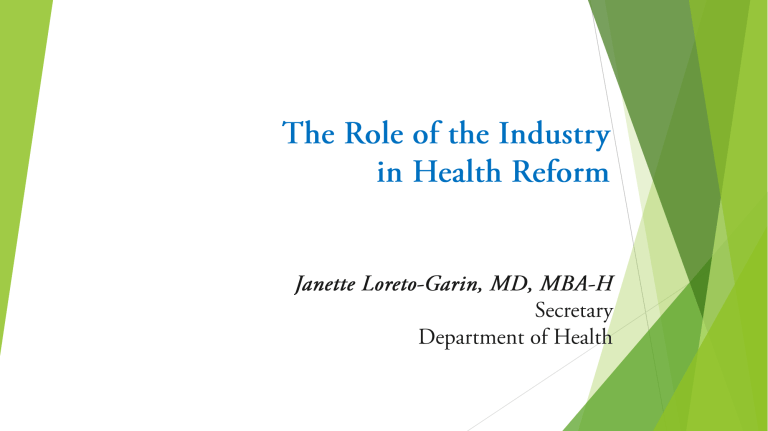Document 14554424

The Philippines
Large population, limited resources
Multiple disease burdens
Uncontrolled large private system of care
High cost of drugs and health services
Variations in access, quality, and costs of
health care
SOCIETAL GOAL
The Universal Health Care Agenda in the Social Contract: Inclusive Growth
Inclusive Growth and Poverty Reduction
SECTOR OUTCOME
Human Development and Poverty Reduction
Access to quality education, training
& culture
HEALTH SUB SECTOR
Access to shelter security
Improved
Health Status
Access to quality social protection
Access to asset reform
Health Status Financial Risk Responsiveness
Protection
Government budget for health
2008-2015
Budget in billion pesos
60
40
20
0
120
100
80
83.7
53.23
42.08
31.83
24.65
2010 2011 2012 2013
Budget in billion pesos
2014
86.58
2015
Increasing cost pressures from pharmaceuticals
•
Pharmaceutical expenditures account for approximately 50% of total health care market and will likely accelerate in growth under UHC
•
Emerging targeted therapies for cancer and other diseases at significant price premiums vs survival gains of few months (i.e. >$100,000 annually)
A country of expensive medicines
Medicines prices in the
Philippines have been historically high compared to other Asian countries and other countries of similar income status.
65% of total out-of-pocket expenditures goes to medicines putting more burden on the poorest quintile of the population (FIES, 2009).
Varying drug procurement prices of medicines in the public sector at different levels
Need to ensure access to medicines in public facilities
WHO-HAI, Public Procurement Prices of Medicines in the Philippines, 2008
High cost makes quality drugs inaccessible
Drug / Indication
Imatinib for CML and GIST
Trastuzumab for Her2+ breast cancer
Erythropoeitin for anemia in CKD (dialysis patients)
Imiglucerase for Gaucher’s disease
Cost per patient
$ 38,804 per year
$65,801 per year
$8,057 per year*
$111,907 per year (lifetime)
Sofosbuvir for Hepatitis C $82,722 for 12 weeks treatment
Innovative pricing schemes for patented medicines
The DOH’s National HIV/STI
Prevention Program has a budget of about $11 million,
60% of which goes to the provision of ARVs to people living with HIV/AIDS.
THE BOTTOM LINE
Important role of the industry to widen access to essential drugs and technologies with high clinical value while ensuring affordability and sustainability of the health system
WHO Six-Point Policy Package to Combat Antimicrobial Resistance
Policy Areas
(1) Committing to develop a master plan to combat antimicrobial resistance
(2) Strengthening surveillance and laboratory capacity
(3) Ensuring uninterrupted access to essential medicines
of assured quality
(4) Promoting rational use of medicines in patient care and
animal husbandry
(5) Enhancing infection prevention and control
(6) Fostering innovations and research to develop new tools and drugs
During the 62 nd WHO regional Committee Meeting in October 2011, the Philippines committed to implementing the six-point policy agenda to combat AMR
Lack of consistent, reliable accessible source of independent and non-promotional information in the
Philippines
Need to align codes of practice with The Mexico City
Principles for Voluntary Codes of Business Ethics in the
Pharmaceutical Industry (APEC, Nov 2011)
Biopharmaceutical and medical device companies must have a united front in committing to ethical codes of practice to fight corruption in the healthcare sector and work effectively in the best interest of patients.
The Industry Contributions

